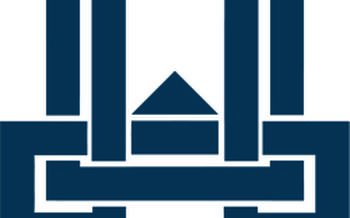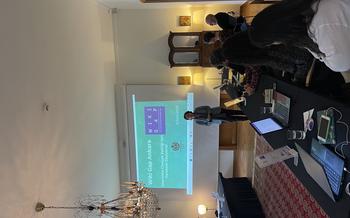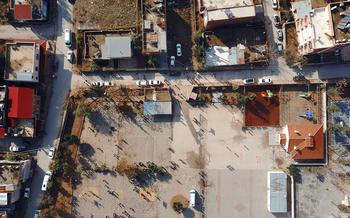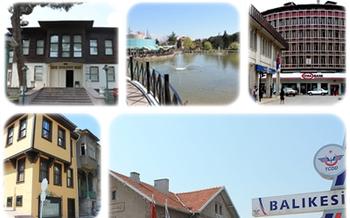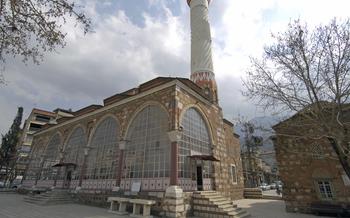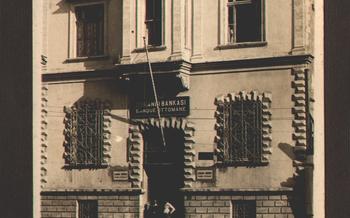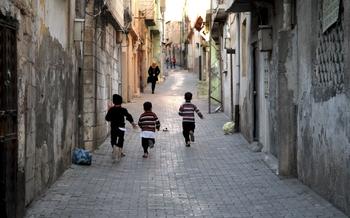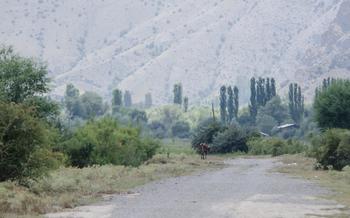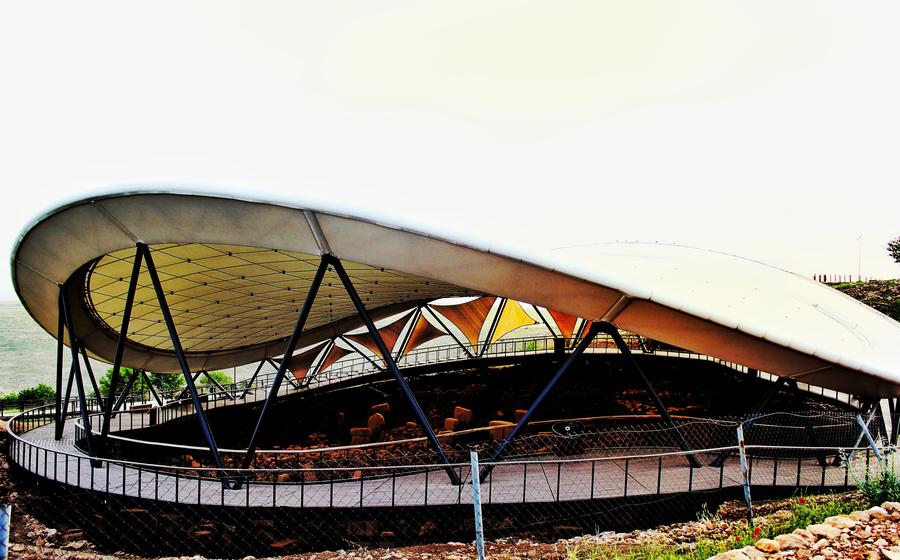
Fatih Paşa Mosque
- History of the Fatih Paşa Mosque
- Architectural Details
- Religious Importance
- Cultural Significance
- Visitor Information:
- Interior Design
- Historical Context
- Restoration and Renovation
- Community Involvement
- Educational Programs
- Local Artisans and Craftsmen
- Interfaith Dialogue
- Tourism and Pilgrimage
- Contemporary Relevance
- Insider Tip
History of the Fatih Paşa Mosque
In the heart of Şanlıurfa, stands the Fatih Paşa Mosque, a captivating monument that narrates the city's rich history and architectural heritage. Built in 1574 during the reign of Ottoman Sultan Selim II, the mosque bears the name of Fatih Paşa, the Ottoman governor of Şanlıurfa at the time. Its construction marked a significant milestone in the Ottoman Empire's expansion, symbolizing the empire's commitment to spreading Islam and consolidating its rule in the region.
The Fatih Paşa Mosque stands as a testament to the architectural prowess of the Ottoman era. Its design embodies the essence of Islamic architecture, blending traditional elements with innovative features. The mosque's striking dome, a hallmark of Ottoman architecture, dominates the skyline, symbolizing the heavens and the connection between the earthly and divine realms. The slender minarets, reaching towards the sky, serve as a call to prayer and a reminder of the importance of faith in everyday life.
Throughout its existence, the Fatih Paşa Mosque played a pivotal role in the city's religious and social fabric. It served as a place of worship, a center for Islamic education, and a gathering place for the community. The mosque's grandeur and spiritual significance made it a focal point for religious festivals and celebrations, attracting worshippers from far and wide. Stories abound of the mosque's role in shaping the lives of the local population, providing solace, guidance, and a sense of belonging.
Architectural Details
The Fatih Paşa Mosque stands out for its unique architectural features, reflecting the grandeur of Ottoman architecture. The mosque's most prominent feature is its majestic dome, a testament to the engineering prowess of the era. The dome, adorned with intricate patterns and calligraphy, dominates the skyline and serves as a symbol of the city's Islamic heritage. The mosque's four minarets, each with three balconies, add to its visual grandeur and provide a sense of symmetry and balance. The minarets serve as a call to prayer and symbolize the mosque's religious significance.
The intricate carvings and ornaments found throughout the mosque showcase the artistry and attention to detail that went into its construction. The walls are adorned with verses from the Quran, beautifully calligraphed in various styles. The mihrab (prayer niche), the focal point of the mosque, is adorned with intricate tilework and carvings, creating a sense of awe and reverence. The minbar (pulpit), from which the imam delivers sermons, is also a masterpiece of craftsmanship, with its intricate carvings and inlaid mother-of-pearl decorations.
The mosque's architecture is a blend of Islamic and Anatolian influences, reflecting the cultural diversity of the region. The use of domes, minarets, and arches is a testament to the mosque's Islamic roots, while the intricate carvings and patterns showcase the Anatolian artistic traditions. The Fatih Paşa Mosque is a true architectural masterpiece, embodying the essence of Islamic art and design.
Religious Importance
The Fatih Paşa Mosque holds immense religious significance for the Muslim community in Şanlıurfa. Serving as a central place of worship, the mosque welcomes devotees from all walks of life to offer their prayers and connect with the divine. During the holy month of Ramadan, the mosque transforms into a vibrant hub of spiritual devotion, with extended prayer sessions, communal iftars (fast-breaking meals), and special religious programs. The serene atmosphere within the mosque fosters a deep sense of tranquility, allowing worshippers to immerse themselves in their faith and seek spiritual solace.
Stories abound of individuals whose lives have been touched by the mosque's sacred presence. One such story is that of a young woman named Ayşe, who found solace and guidance within the mosque's walls during a difficult period in her life. Through the support and prayers of the mosque's community, she was able to overcome her challenges and find renewed hope and strength. The Fatih Paşa Mosque stands as a testament to the power of faith and the enduring spiritual legacy of Şanlıurfa.
Cultural Significance
The Fatih Paşa Mosque stands as a testament to the rich cultural heritage of Turkey and the enduring legacy of Islamic traditions. As a symbol of faith and devotion, the mosque has played a pivotal role in preserving and promoting Islamic culture within the city of Şanlıurfa.
The mosque's intricate architecture, with its blend of Ottoman and Islamic influences, reflects the artistry and craftsmanship of its builders. Its towering minarets and elegant dome dominate the city's skyline, serving as a beacon of faith and cultural identity for the local population.
Throughout its history, the mosque has been a center for Islamic learning and scholarship. Renowned scholars and theologians have gathered within its walls to impart knowledge and foster a deeper understanding of the Islamic faith. The mosque's library houses a treasure trove of Islamic texts and manuscripts, contributing to the preservation and dissemination of Islamic knowledge.
The Fatih Paşa Mosque has also played a significant role in promoting Islamic traditions and customs. During religious festivals and celebrations, such as Eid al-Fitr and Eid al-Adha, the mosque becomes a hub of activity as worshippers gather to offer prayers, exchange greetings, and share the joy of the occasion. These celebrations not only strengthen the bonds of community but also showcase the vibrant traditions of Islamic culture.
Visitor Information:
The Fatih Paşa Mosque is conveniently located in the heart of Şanlıurfa, making it easily accessible to visitors. The mosque is open to the public daily, allowing you to visit at your convenience. Admission is free of charge, and visitors are welcome to explore the mosque's stunning architecture, intricate interiors, and serene atmosphere. To maintain the sanctity of the mosque, visitors are kindly requested to dress modestly and respectfully. Women should cover their heads, and both men and women should avoid wearing shorts or tank tops. Visitors are also reminded to maintain silence and avoid disturbing others engaged in prayer. Guided tours are available upon request, providing an in-depth understanding of the mosque's history, architecture, and religious significance.
Interior Design
The interior of the Fatih Paşa Mosque is a masterpiece of Islamic art and design. The intricate tilework and calligraphy that adorn the walls and ceiling create a breathtaking visual spectacle. The mihrab (prayer niche) is particularly impressive, with its intricate carvings and colorful tiles. The minbar (pulpit) is also a work of art, with its finely crafted wood carvings and intricate inlays.
One of the most striking features of the mosque's interior is the overall sense of space and light. The large windows and high ceilings create a feeling of airiness and openness, while the soft, muted colors of the interior create a sense of tranquility and peace.
The Fatih Paşa Mosque is a living example of the rich artistic and cultural heritage of Turkey. Its intricate tilework, calligraphy, and carvings are a testament to the skill and artistry of the Ottoman craftsmen who built it. The mosque's interior is a place of beauty and inspiration, where visitors can come to reflect on their faith and connect with the divine.
Historical Context
The Fatih Paşa Mosque stands as a testament to the rich history of Şanlıurfa, deeply rooted in the political and social climate that shaped its construction. During the Ottoman Empire's reign, Şanlıurfa served as a strategic hub, connecting the empire's eastern and western territories. The construction of the mosque reflected the Ottomans' desire to assert their dominance and solidify their presence in the region.
The mosque's location within the city's bustling commercial center further emphasized its significance. It served as a focal point for trade and commerce, attracting merchants and visitors from across the empire. The mosque's construction also coincided with a period of cultural and intellectual flourishing in Şanlıurfa. The city became a center of Islamic scholarship and learning, with the mosque serving as a gathering place for scholars, theologians, and students.
Beyond its religious and commercial importance, the Fatih Paşa Mosque played a vital role in fostering a sense of community among the city's residents. It became a place where people from all walks of life could come together for prayers, celebrations, and social gatherings. The mosque's presence contributed to the city's strong sense of identity and unity, making it an integral part of Şanlıurfa's historical fabric.
Restoration and Renovation
The Fatih Paşa Mosque has undergone several restoration and renovation efforts throughout its history. In the early 20th century, the mosque faced significant deterioration due to neglect and the effects of time. Recognizing its cultural and historical importance, the Turkish government initiated a comprehensive restoration project in the 1950s. This project involved meticulous repairs to the mosque's structure, including the strengthening of the foundations, the restoration of the domes and minarets, and the repair of damaged tiles and carvings.
One of the challenges faced during the restoration process was the need to preserve the mosque's original features while incorporating modern techniques to ensure its longevity. The restoration team worked diligently to maintain the mosque's architectural integrity, using traditional materials and craftsmanship to replicate the original design.
The successful restoration of the Fatih Paşa Mosque not only preserved its architectural heritage but also ensured that it could continue to serve as a place of worship and a symbol of cultural identity for the community. The mosque's restoration stands as a testament to the importance of preserving historical landmarks and ensuring their continued relevance for future generations.
Community Involvement
The Fatih Paşa Mosque serves as a vibrant hub for community engagement, fostering a sense of belonging and togetherness among the local residents. The mosque's doors are always open, welcoming people from all walks of life to participate in various charitable and social activities. These initiatives play a crucial role in strengthening the bonds within the community and promoting unity and cooperation.
One of the mosque's notable contributions is its involvement in charitable work. The mosque's charitable committee organizes regular food drives, clothing donations, and financial assistance programs to help those in need. These initiatives demonstrate the mosque's commitment to social welfare and its dedication to helping the less fortunate members of the community.
The mosque also serves as a gathering place for community events and celebrations. During religious festivals and holidays, the mosque hosts special prayers, gatherings, and feasts, bringing the community together to celebrate and share in the festivities. These events provide an opportunity for people to connect, strengthen their bonds, and create lasting memories.
Moreover, the mosque's courtyard often serves as a venue for community meetings, workshops, and educational programs. These events cover various topics, including religious teachings, social issues, and community development initiatives. By providing a platform for dialogue and discussion, the mosque fosters a sense of empowerment and encourages active participation in community affairs.
Anecdotes or stories:
-
During the holy month of Ramadan, the mosque organizes communal iftars (fast-breaking meals) that bring together hundreds of people from the neighborhood. These iftars not only provide nourishment but also create a strong sense of community and togetherness.
-
The mosque's youth group regularly organizes volunteer clean-up campaigns in the surrounding area, demonstrating their commitment to environmental stewardship and community service.
-
The mosque's courtyard often hosts traditional games and activities for children during religious holidays, creating a festive atmosphere and promoting intergenerational bonding.
Educational Programs
The Fatih Paşa Mosque serves as a hub for religious education and guidance, offering a diverse range of classes, workshops, and seminars. These educational initiatives aim to promote Islamic knowledge and understanding among the community members.
One of the most popular programs is the Quranic recitation class, where students of all ages learn the proper techniques of reciting the holy book. The mosque also offers classes on Islamic history, theology, and jurisprudence, taught by experienced scholars and religious leaders.
In addition to formal classes, the mosque organizes regular workshops and seminars on various Islamic topics. These events provide a platform for open discussions, debates, and Q&A sessions, allowing participants to engage with Islamic scholars and gain deeper insights into their faith.
The mosque's educational programs play a vital role in fostering a sense of community and belonging among the Muslim population. By providing opportunities for learning and spiritual growth, the mosque contributes to the preservation and transmission of Islamic traditions and values to future generations.
One memorable anecdote related to the mosque's educational programs is the story of a young woman named Amina. Amina had always been curious about Islam but had never had the opportunity to learn more. When she heard about the mosque's educational programs, she decided to enroll in a Quranic recitation class.
To her surprise, Amina found the classes to be both enjoyable and enlightening. She quickly formed a close bond with her teacher and classmates, who were always willing to help and support her. As she progressed in her studies, Amina's understanding of Islam deepened, and she felt a growing sense of connection to her faith.
Amina's experience is just one example of how the Fatih Paşa Mosque's educational programs are making a positive impact on the lives of individuals and the community as a whole. Through these initiatives, the mosque is actively contributing to the propagation of Islamic knowledge and fostering a deeper understanding of the religion among its followers.
Local Artisans and Craftsmen
The construction of the Fatih Paşa Mosque was a testament to the skill and artistry of local artisans and craftsmen. These master builders, carpenters, and masons employed traditional techniques passed down through generations to create a masterpiece of Islamic architecture. The intricate carvings, delicate tilework, and stunning calligraphy that adorn the mosque's interior and exterior are a testament to their exceptional craftsmanship.
One of the most striking features of the mosque is its intricate stone carvings. Local artisans spent countless hours meticulously chiseling intricate patterns and motifs into the stone, creating a breathtaking visual display. The carvings depict verses from the Quran, geometric designs, and floral patterns, adding a layer of beauty and symbolism to the mosque's architecture.
The mosque's stunning tilework is another testament to the skill of local artisans. Colorful tiles, hand-painted with vibrant hues and intricate patterns, adorn the walls, mihrab, and minarets. The tiles depict scenes from Islamic history, geometric designs, and verses from the Quran, creating a vibrant and visually captivating display.
The mosque's restoration efforts have played a crucial role in preserving the work of these talented artisans. Skilled craftsmen have meticulously repaired and restored the intricate carvings, tilework, and calligraphy, ensuring that these masterpieces continue to inspire and awe visitors for generations to come.
Interfaith Dialogue
The Fatih Paşa Mosque has been at the forefront of promoting interfaith dialogue and understanding in Şanlıurfa. The mosque has hosted numerous events, workshops, and seminars aimed at fostering harmonious relationships between different faiths. These events bring together people from diverse religious backgrounds to discuss common values, share experiences, and learn from one another. The mosque's commitment to interfaith dialogue has created a platform for cultural exchange and cooperation, helping to break down barriers and build bridges of understanding between different communities.
One notable initiative is the annual Interfaith Dialogue Forum, which brings together religious leaders, scholars, and community members from various faiths to discuss pressing issues and promote peaceful coexistence. The forum provides a safe space for open dialogue, where participants can share their perspectives and engage in meaningful conversations. Through these initiatives, the Fatih Paşa Mosque plays a vital role in promoting mutual respect, cooperation, and understanding among people of different faiths, contributing to a more harmonious and inclusive society.
Tourism and Pilgrimage
The Fatih Paşa Mosque holds a significant place in both tourism and pilgrimage. As a renowned pilgrimage site for Muslims, it attracts countless devotees from around the world who come to pay their respects and seek spiritual enlightenment. The mosque's rich history, stunning architecture, and religious significance make it a must-visit destination for pilgrims seeking a profound spiritual experience.
Additionally, the mosque's architectural beauty and cultural significance draw a large number of tourists who are eager to explore its intricate details and learn about its history. The mosque's unique features, such as its impressive dome, towering minarets, and intricate tilework, make it a captivating sight for visitors of all faiths.
The influx of tourists and pilgrims has a positive impact on the city's economy, contributing to job creation and the development of local businesses. The mosque's presence has also fostered a sense of pride and cultural identity among the local community, as it serves as a tangible reminder of their rich heritage.
Anecdote:
During my visit to the Fatih Paşa Mosque, I witnessed the profound impact it had on both pilgrims and tourists. I observed a group of pilgrims deeply absorbed in prayer, their faces radiating with devotion as they sought spiritual guidance and blessings. I also encountered a group of tourists who were in awe of the mosque's architectural grandeur, taking pictures and eagerly learning about its history from a knowledgeable guide. The mosque's ability to cater to both spiritual seekers and history enthusiasts made it a truly remarkable and inclusive destination.
Contemporary Relevance
The Fatih Paşa Mosque remains a prominent symbol of faith and cultural heritage in modern-day Turkey. While its historical significance is undeniable, the mosque continues to play a vital role in shaping contemporary Islamic thought and practice. It serves as a center for religious education and guidance, offering classes, workshops, and seminars to promote Islamic knowledge and understanding. The mosque also actively engages in interfaith dialogue and cooperation, fostering harmonious relationships between different faiths. By embracing modern technology and social media platforms, the Fatih Paşa Mosque effectively communicates its message of peace, tolerance, and mutual respect to a global audience. Through its ongoing relevance and adaptability, the mosque continues to inspire and guide Muslims and visitors alike, bridging the past with the present and shaping the future of Islamic faith and culture.
Insider Tip
-
To fully appreciate the mosque's beauty and tranquility, visit during the early morning or evening, when the sunlight casts a warm glow on the exterior and the interior is less crowded.
-
When visiting the mosque, be sure to dress modestly and respectfully. Women should cover their heads with a scarf or shawl, and both men and women should avoid wearing shorts or revealing clothing.
-
Take advantage of the mosque's free guided tours, which provide valuable insights into its history, architecture, and religious significance. Guided tours in multiple languages are available upon request.
-
As you wander through the mosque, take a moment to pause and admire the intricate details and craftsmanship that adorn every corner. Notice the stunning tilework, the delicate carvings, and the beautiful stained glass windows that let in a soft, colorful light.
-
For a truly memorable experience, visit the mosque during one of the many religious festivals or celebrations held throughout the year. These events showcase the mosque's vibrant spiritual atmosphere and provide a glimpse into the local culture and traditions.
